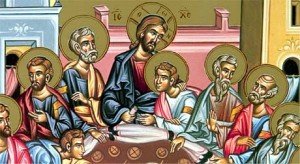One of the things we know about the development of our Divine Liturgy is that it rarely eliminated things that became a part of it over the years. The prayers that follow the Great Litany, namely the First Antiphon, the Hymn of the Incarnation, the Small Litany and the Second Antiphon were all originally celebrated as a part of a procession to the worship space and the bringing of the Gospel Book from a secure location to the Ambon, the raised platform in the center of the church building where the clergy were gathered at the beginning of the Liturgy. It was only in Constantinople that the Great Litany was placed before the antiphons as a way to begin the procession that brought the clergy and people to the worship space. The more ancient position in the Liturgy for the petitions was after the various scriptural readings and the sermon. The Eastern Church, as you know, loves processions and some sort of procession is integrated into most major services and feasts. As we know, there are still two major processions in the Liturgy, the Small and the Great Processions.
What is the meaning of these two processions? Think about how they are performed today. Both the Gospel Book and the Gifts are brought from the altar area, through the church and back to the Holy Table. These symbolize that both the Word of God (Gospel) and Life (food in the form of bread and wine) come from heaven (God) to us with the expectation that, if we believe, they have the power to lead us back to heaven and union with God. Remember that the nave, that portion of the church were the faithful are during the Liturgy, symbolizes the earthly Kingdom of God.
The antiphons are really verses from various Psalms with a special refrains in between these verses. They are now standardized but, originally, any Psalm could be used. On major feasts the Tropar of the feast served as the refrain between the Psalm verses.
You will remember that the Hymn of the Incarnation was only added to the Liturgy by Emperor Justinian after the Councils of the Church defined the Incarnation and that Jesus is truly God and Man. It is important, as we sing this Hymn, that we think about what it really says and that we make it a moment when we make a profession of our faith that Christ is truly God and truly Man.
If you think about these things when we are celebrating them, it truly has the power to enhance our worship and our understanding of our faith.

